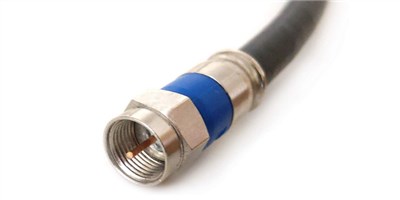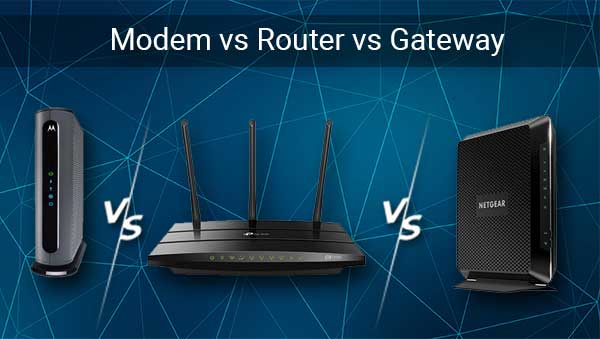When we want to troubleshoot network issues we usually look online for a solution, and the terms modem, router, and gateway get thrown around a lot. The really confusing part is that we get more or less the same troubleshooting process for these.
However, these three devices are quite different in terms of hardware components and functionality. Therefore, this article is going to discuss the difference between cable modems, routers, and gateways.
CONTENTS
What Is a Modem and How Does It Work?
All ISPs (Internet Service Providers), upon signing a contract and subscribing to their service, provide their equipment so you can have internet access in your home. Of course, you can buy your equipment, but you still need their internet services.
One of those pieces of equipment is the modem, and it’s essential for having internet access on your home network. The modem is short for modulator/demodulator, and this hardware component modulates and demodulates the signal from the cables.
The modulator converts the data from its digital form into analog signals so they can be transmitted using wires. The demodulator takes the analog signal and returns it to digital form, so we get the data on our device.
Different Types of Modems
Essentially, there are two different types of modems, the cable modem, and the DSL modem. Cable modems are connected to an internet service provider through a coaxial cable network that provides internet access.
Coaxial cables are very efficient in transmitting electrical signals that are later transformed into digital data. Plus, they are quite cheap and easy to deploy. This is why it’s one of the more common ISPs.

DSL modems are different because they use twisted-pair copper wiring to transmit the signal from and to your internet service provider.
These are less efficient, but they’re cheaper because they’re a part of the telephone line network which is already deployed almost everywhere.
What Is a Router and How Does It Work?
The other essential networking piece of hardware we need in our home is the router. This is the device that establishes our LAN (Local Area Network). The essential function of the router is NAT (Network Address Translation).
The router assigns IP addresses to every device in the home network, and it uses them to direct the traffic within the network. When we receive data packets from the internet, they go through the modem, they reach the router, and they’re directed to the device that requested that info.
Different Types of Routers
Like with modems, we also have different types of routers. We can differentiate them according to how many bands they support because there are dual-band and tri-band routers at the moment, supporting 2.4 GHz and two 5 GHz bands. Nevertheless, there are 5 essential router types:
- Wireless routers: These are the most common kind of router, and they’re used to establish wireless connectivity in offices, cafes, restaurants, bars, public spots, and our homes.

- Wired routers: As the name suggests, these are the opposite of wireless routers. They connect the devices that are part of the network using ethernet cables, but they can act as a Wi-Fi access point as well.
- Virtual routers: These are the software equivalent to a hardware router, and they have the same functionality. They can serve as a backup when the regular router stops working, but they need hardware to work.
- Core routers: When you request something online, it goes from your device to your router, from the router to the modem, and then it goes to the core router, the device in the network’s backbone.
- Edge routers: Like core routers, these have an important role in networking. They are routers that are located on the edge of the network, that’s why they’re called edge routers, and they connect internal networks to external networks. I.e. the WAN (Wide Area Network) and the internet.
What Is a Gateway?
Currently, this is the most common piece of hardware ISPs provide to subscribers. Instead of getting two different components that make up your home network, you get one device that does it all.
Recommended reading:
- How to Connect Hue Bridge Without Ethernet Cable?
- How to Connect Two Wi-Fi Routers Without a Cable? (Is it Possible and How to Do It?)
- How to Fix the Xfinity Cable Box Blinking Green Light?
This device is a gateway. It’s a modem/router combo. So, it performs the modulation and demodulation, but it also establishes a wireless/wired network among your devices by assigning IP addresses and transmitting data packets.
Modem vs. Router vs. Gateway

Now, let’s make a comparison between these three devices for reference purposes. First, let’s talk about digital to analog conversion and vice versa. The router can’t do this, but the modem and gateway can.
Second, network address translation can only be performed by the router and the gateway. Unfortunately, a modem can’t route information across the network, so you need to have either a router or a gateway to establish a network.
Third, internet access. A gateway and a modem can provide internet access because they’re connected to your ISP. If you plug a router in and try to connect to the internet without connecting the router to a modem, you won’t have any luck.
Finally, wireless networking. Both a gateway and a router have wireless adapters, and that’s why they can emit a wireless frequency and establish a wireless network. A modem can only provide a wired connection to the internet.
Conclusion
The main difference between cable modems, routers, and gateways is their functionality. A gateway is essentially both a router and a modem. Modems provide internet access to our devices, but routers are the ones that establish a home network.
There are several types of modems and the ones that are used depend on the type of service the ISP provides. Finally, the type of router also depends on where they’re located and what its purpose is.

Hey, I’m Jeremy Clifford. I hold a bachelor’s degree in information systems, and I’m a certified network specialist. I worked for several internet providers in LA, San Francisco, Sacramento, and Seattle over the past 21 years.
I worked as a customer service operator, field technician, network engineer, and network specialist. During my career in networking, I’ve come across numerous modems, gateways, routers, and other networking hardware. I’ve installed network equipment, fixed it, designed and administrated networks, etc.
Networking is my passion, and I’m eager to share everything I know with you. On this website, you can read my modem and router reviews, as well as various how-to guides designed to help you solve your network problems. I want to liberate you from the fear that most users feel when they have to deal with modem and router settings.
My favorite free-time activities are gaming, movie-watching, and cooking. I also enjoy fishing, although I’m not good at it. What I’m good at is annoying David when we are fishing together. Apparently, you’re not supposed to talk or laugh while fishing – it scares the fishes.
